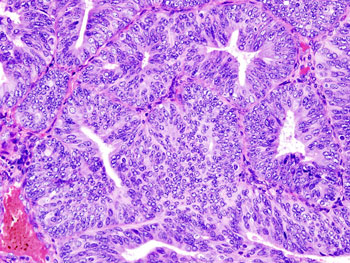Study Finds Five New Genetic Risk Loci for Endometrial Cancer
By LabMedica International staff writers
Posted on 16 May 2016
Genome-wide association studies (GWAS) have revealed five previously unknown risk loci for endometrial cancer.Posted on 16 May 2016
Endometrial cancer is the third most common cause of death from women's cancers, behind ovarian and cervical cancer. It is more common in the developed world and is the most common cancer of the female reproductive tract in developed countries. Rates of endometrial cancer have risen in a number of countries, and this is believed to be due to the increasing number of elderly people and increasing rates of obesity.

Image: A histologic view of an endometrial adenocarcinoma showing many abnormal nuclei (Photo courtesy of Wikimedia Commons).
In a study designed to identify genetic risk indicators for endometrial cancer, investigators at the University of Cambridge (United Kingdom) and QIMR Berghofer Medical Research Institute (Brisbane, Australia) conducted a meta-analysis of three endometrial cancer genome-wide association studies and two follow-up phases totaling 7,737 endometrial cancer cases and 37,144 controls of European ancestry.
Results revealed five new risk loci of genome-wide significance. They also identified an allele that was protective in endometrial cancer by suppressing gene expression in vitro, suggesting that regulation of the expression of KLF5 (Krueppel-like factor 5), a gene linked to uterine development, was implicated in tumor development.
Contributing author Dr. Deborah Thompson a senior research associate in genetic epidemiology at the University of Cambridge, said, "Our findings help us to paint a clearer picture of the genetic causes of endometrial cancer in women, particularly where there no strong family history of cancer. Prior to this study, we only knew of four regions of the genome in which a common genetic variant increases a woman's risk of endometrial cancer. In this study we have identified another five regions, bringing the total to nine. This finding doubles the number of known risk regions, and therefore makes an important contribution to our knowledge of the genetic drivers of endometrial cancer."
"As we develop a more comprehensive view of the genetic risk factors for endometrial cancer, we can start to work out which genes could potentially be targeted with new treatments down the track," said senior author Dr. Amanda Spurdle, group leader in molecular cancer epidemiology at QIMR Berghofer Medical Research Institute. "In particular, we can start looking into whether there are drugs that are already approved and available for use that can be used to target those genes."
The study was published in the May 2, 2016, online edition of the journal Nature Genetics.
Related Links:
University of Cambridge
QIMR Berghofer Medical Research Institute














